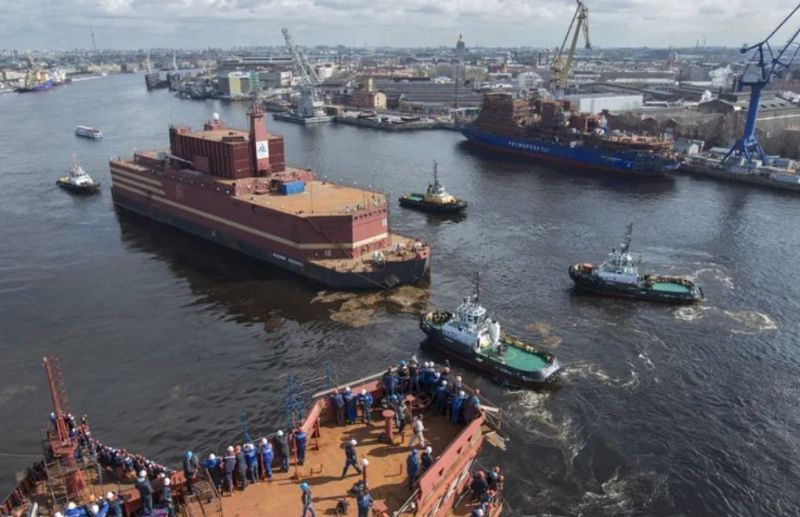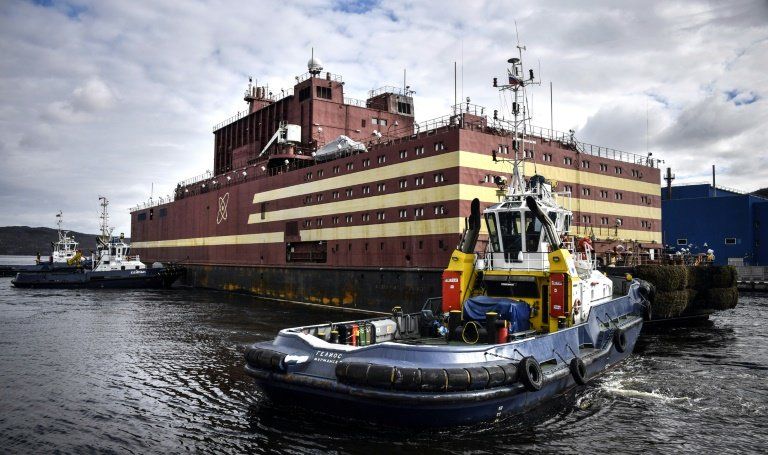
To meet its growing electricity needs in its drive to develop oil resources in remote Arctic regions, Russia has built a floating nuclear power station, a project that detractors deride as a "Chernobyl on ice".
Built in Saint Petersburg, the Akademik Lomonosov is currently moored in Murmansk where it is being loaded with nuclear fuel before heading to eastern Siberia.
On Saturday, head of state nuclear power firm Rosatom unveiled the brown-and-mustard-painted facility in the city's estuary as an orchestra played the national anthem.
Rosatom chief Alexei Likhachev hailed the new power station as "a new world first," which he said "underlines the undoubted leading role of Rosatom and the Russian nuclear energy sector on the global agenda."
"I hope today will be a symbolic day for the Arctic," Likhachev said, adding that Rosatom "is setting a trend, a demand for medium-capacity nuclear facilities, mobile facilities, for many decades ahead."
The 144-by-30-metre (472-by-98-foot) barge holds two reactors with two 35 megawatt nuclear reactors that are similar to those used to power icebreaker ships.
The Akademik Lomonosov will be towed in the summer of 2019 to the port of Pevek in the autonomous Chukotka region in Russia's extreme northeast.
The barge can produce enough electricity to power a town of 200,000 residents, far more than the 5,000 live in Russia's northernmost town.
But Akademik Lomonosov isn't in Pevek to just keep the lights on in homes.
As Russia is forced to push further north into the Arctic in the search for oil and gas, it needs electricity in far-flung locations.
"The idea is to have low-capacity, mobile power plants that can be used in the Russian Arctic where large amounts of electricity aren't needed" and the construction of a conventional power station would be complicated and costly, said Sergei Kondratyev at the Institute for Energy and Finance in Moscow.
"The alternatives are coal, gas and diesel. But diesel is very costly," he said, while the gas needs to be delivered as liquefied natural gas or LNG.
Vitaly Trutnev, who is in charge of the construction and operation of floating nuclear power stations at Rosatom, said such units would "supply electricity and heat to the most remote regions, supporting also growth and sustainable development."
He said use of such floating reactors can save 50,000 tonnes of carbon dioxide emissions per year.
The Akademik Lomonosov is set to replace an ageing nuclear reactor and a coal-fired power plant which are both located in Chukotka.
Trutnev said the barge has "the latest security systems and should be one of the safest nuclear installations in the world."
Activists at the environmental group Greenpeace are not convinced and call for international monitoring.
They fear that the Akademik Lomonosov could become a "nuclear Titanic" or a "Chernobyl on ice" 32 years after the Soviet nuclear disaster.
Greenpeace Russia's Rashid Alimov said that accidents are possible at all nuclear power plants, but that the barge "will be especially sensitive to storms, environmental phenomena and threats such as terrorism."
He said a shift to more numerous small reactors would pose risks for proliferation of nuclear material.
Greenpeace nuclear expert Jan Haverkamp noted that the Akademik Lomonosov is being fuelled near Murmansk, a city of 300,000, before being towed across the Arctic.
"Its installation in the tough environment of the Russian Arctic will pose a constant threat for residents of the north and the Arctic's pristine nature," said Haverkamp.
The barge had initially been scheduled to be fuelled in Saint Petersburg, but that work was moved to Murmansk instead due to concern in countries along the Baltic Sea.
Kondratyev at the Institute for Energy and Finance in Moscow downplayed safety concerns about the barge, insisting it met the same safety rules as nuclear icebreakers and submarines.
"But it is a new piece of equipment. There may be concerns among the general populace, but there are additional risks compared to nuclear power plants," he said.
Rosatom chief Likhachev said Saturday that the corporation hopes to build more such barges and to find Asian clients in need of power in remote regions, giving the examples of Indonesia and Philippines.
"In certain cases a floating nuclear power plant is more cost-effective than other electric power plants ... it has its own niche," Kondratyev said.
He said China is also building a floating nuclear power plant.



We use cookies to improve your experience. By continuing to use our site, you accept our Cookies, Privacy Policy,Terms and Conditions. Close X